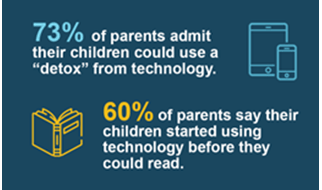In a world where the youngest digital natives are swiping before they can speak, many children are mastering screens before they even learn to read. According to the 2025 Bright Horizons Modern Family Index (MFI), 73% believe their children need a digital detox. This number is more than a statistic, it’s a wake-up call.
As a society, we’ve embraced technology for its convenience and educational potential. But we’re also seeing the unintended consequences: concerns about mental health, reduced physical activity, and a growing reliance on screens for entertainment and behavior management. “We are helping these little people develop the foundation they need for the rest of their lives,” Rachel Robertson, Chief Academic Officer at Bright Horizons says. “What do children need now in their development, in the amazing first five years of life, that will prepare them to thrive for the rest of their life? Screens do not add to any of that early development—and in fact, they can really detract from it, and we can’t get that time back.”
At Bright Horizons, we believe it’s time to shift the narrative from screen time panic to screen time with purpose. So, how do we do that?
1. Start with awareness and intentionality
The first step in managing screen time for kids is to understand how and why they are using it. The MFI report shows that 58% of parents use technology to keep children quiet in public, and 55% use it as a bargaining tool. These are real-life strategies that reflect the pressures of modern parenting—not failures. But they also highlight the need for intentionality.
Instead of focusing solely on ‘how much screen time is too much’, we should ask: How is my child using the screen? Is it passive or active? Is it replacing something more valuable?
2. Make waiting time enjoyable
One of the most common times children are handed a device is during waiting periods—at restaurants, in lines, or during car rides. “For example,”, says Robertson, an early-education expert, “if you take your little kid to the grocery store and they are starting to fuss while sitting in the shopping cart, you might give them a screen as a distraction”. “It certainly helps them, in the moment, to calm down. But long-term, they have missed an opportunity to develop regulation skills, to manage emotions, and to build their executive function to persist through waiting times,” she explains .
But these moments can be transformed into opportunities for connection and learning. With a bit of forethought and preparation, waiting time can be made fun and educational – without defaulting to screen time for kids. Try playing simple games like “I Spy,” storytelling, or counting and sorting items to turn idle time into brain-boosting time. You can even carry a bag of safe, age-appropriate materials to be used while waiting – everyday materials like pipe cleaners, bubbles, playdough, etc. will do the trick.
3. Embrace boredom as a gift
In a culture that prizes constant stimulation, boredom can feel like a problem. But it’s actually a powerful catalyst for creativity and self-regulation. When children are bored, they learn to entertain themselves, solve problems, and use their imaginations—skills that no app can teach. A stick can become a wand; a small blanket can become a cape; and a cardboard box can become a castle. A stretch of time with nothing to do can allow new ideas to germinate. It also aids in self-discovery by understanding what they are naturally curious about and interested in.
4. Invest in time outside
Outdoor play is a powerful way to unplug and reconnect. Whether it’s a walk, bike ride, or backyard picnic, time outside encourages creativity, movement, and meaningful family connection. Activities like nature scavenger hunts, gardening, or storytelling under the sky turn everyday moments into lasting memories. These screen-free experiences support children’s development and emotional well-being—while giving everyone a healthy break from devices. Step outside and let nature bring your family closer.
5. Model healthy habits
Children learn more from what we do than what we say. If we want them to have a balanced relationship with technology, we need to first model it ourselves. Participate in regular screen-free time as a family. That means putting down our own devices, being present, and showing that life offline is rich and rewarding. You could even consider setting screen-free zones of the house or screen-free times throughout the day. For example, you can decide that screen time for kids is not allowed in bedrooms or during dinner. Referring to expert guidelines on recommended screen time by age can help set realistic and developmentally appropriate boundaries.
The Bottom Line
Technology is here to stay, and when used with purpose, becomes a powerful tool. Hands-on, minds-on — that’s how children learn best and when they can touch, wonder, explore, and discover, the opportunities are endless. The goal is to help children develop the foundation they need for the rest of their lives. Since they are going to be future adults, let us be in constant pursuit of what they need now – in the first amazing five years of life – that will prepare them to thrive for the rest of their lives. Let’s work together to create those opportunities for children and navigate this digital landscape with confidence, compassion, and clarity—because childhood should be about more than just screen time. It should be about real time.
This article has inputs from Rachel Robertson, Chief Academic Officer, Bright Horizons.





